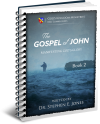Latest Posts
View the latest posts in an easy-to-read list format, with filtering options.

Jesus manifested God's glory through 8 miraculous signs in the gospel of John. These are a revelation of the feast of tabernacles.
Category - Bible Commentaries

The fourth and fifth signs in John are presented to us back to back with no commentary separating them. The commentaries on both of these signs come afterward and extend through the eighth chapter of John.
These signs, therefore, must be linked together in order to understand either one of them. The two form a complete story, because they prophesy of the two comings of Christ. One must understand both in order to truly know how Passover and Tabernacles relate and how they differ.
One irony, as we will see, is that in the fourth sign (Passover), the people wanted to proclaim Jesus as King. But in the fifth sign (Tabernacles), they wanted to kill Him (John 7:19). From God’s perspective, they mixed up the two feasts. They were supposed to kill Him as the Lamb at Passover and crown Him King at Tabernacles. They did not know the times and seasons.
When the people began to discuss proclaiming Jesus to be their King, He questioned His own disciples as to who they believed He was. Peter answered, “The Christ of God” (Luke 9:20). According to Luke’s account, this took place just prior to Jesus’ transfiguration (Luke 9:29). Matthew and Mark both tell us that Peter’s revelation came to him at Caesarea Philippi (Matt. 16:16; Mark 8:29), at the base of Mount Hermon, where He was soon to be transfigured.
It appears, then, that the discussion about Jesus’ identity started when Jesus fed the multitude but remained incomplete until later. But meanwhile Jesus withdrew (ascended) into the nearby mountain and sent His disciples across the lake back to Bethsaida (Mark 6:45). The storm arose, and Jesus came to them, walking on the water. Peter went out to meet Him, escorting Him to the boat, and immediately they found themselves not at Bethsaida but to the west at nearby Capernaum (John 6:17, 24).
It appears that from Capernaum, Jesus and His disciples went north to Caesarea Philippi, where Peter finally received His revelation, “You are the Christ, the Son of the living God” (Matt. 16:16). From there He took three disciples up Mount Hermon where He was transfigured.
For now, we will pass over the fifth sign (John 6:16-21) and go directly to the commentary on the fourth sign, which is found in the last half of John 6. John 6:22 begins,
22 The next day [after the storm] the multitude that stood on the other side of the sea saw that there was no other small boat there, except one, and that Jesus had not entered with His disciples into the boat, but that His disciples had gone away alone.
Jesus Himself had ascended the mountain unnoticed in order to prevent the people from crowning Him as King. The people only saw the disciples get into the boat. But in the morning, Jesus was nowhere to be found, for He had already joined the disciples in the middle of the night.
One small boat was still moored on the shore. Soon other boats arrived from the small town on the west side of the lake. Apparently, the news had already spread to Tiberias, and people came hoping to witness more such miracles. John 6:23 says,
23 There came other small boats from Tiberias near to the place where they ate the bread after the Lord had given thanks.
However, they were disappointed, for they learned that neither Jesus nor His disciples were there. John 6:24, 25 says,
24 So when the crowd saw that Jesus was not there, nor His disciples, they themselves got into the small boats and came to Capernaum, seeking Jesus. 25 When they found Him on the other side of the sea, they said to Him, “Rabbi, when did You get here?”
Jesus did not answer their question, but no doubt they heard it from the disciples. The two miracles were so amazing that word spread fast that miracles were being done. It appears that this was when Jesus truly became famous. So Mark 6:54-56 says,
54 When they got out of the boat [at Capernaum], immediately the people recognized Him, 55 and ran about that whole country and began to carry about on their pallets those who were sick to the place they heard He was. 56 Wherever He entered villages, or cities, or countryside, they were laying the sick in the market places and entreating Him that they might just touch the fringe of His cloak; and as many as touched it were being cured.
John said nothing of this in his account, for his purpose was to focus upon the teaching that Jesus did, which explained the signs in question. Yet the other gospels put it into its proper context.
John 6:26, 27 says,
26 Jesus answered them and said, “Truly truly, I say to you, you seek Me, not because you saw signs, but because you ate of the loaves and were filled. 27 Do not work for the food which perishes, but for the food which endures to eternal life, which the Son of Man shall give to you, for on Him the Father, even God, has set his seal.”
When people are poor, it is easy for men to tempt them to become followers of Christ by offering them “food.” For many of them, obtaining daily food was a struggle. A poverty mindset makes them vulnerable to offers of “prosperity.” Even today we often see how men are bribed into following Christ with promises of prosperity.
Jesus said that their motives were wrong. They were not to follow Him in order to prosper and be fed daily, but to seek the spiritual food that would cause them to grow and mature in their relationship to God. The people saw (or heard about) the miracle that He did, but they did not truly see (understand) the sign itself.
Hence, John collected teachings of Jesus to explain the sign and to give us an understanding of the meaning and purpose of Passover.
The rabbis had often discussed the seal of God, settling on the idea that it was amet, “Truth.” In Hebrew amet is spelled alef-mem-tav. John Lightfoot tells us,
“Resh Lachish saith, alef is the first letter of the alphabet, mem the middle, and tav the last…. I the Lord am the first; I received nothing of any one; and beside me there is no God; for there is not any that intermingles with me; and I am the last.” [Commentary on the New Testament from the Talmud and Hebraica, Vol. 3, page 303]
In other words, to know Truth, one must know its origin, its end (goal or purpose), as well as everything in the middle. The Hebrew word for Truth is also the word for Faith, because faith comes by hearing the revelation of Truth from God. In other words, there is no genuine Faith apart from receiving a measure of Truth on which to base that Faith. Believing a lie is not true faith.
Jesus told the people that true food was the Truth which He was teaching them, and that the Father had put His “seal” (of Truth) upon Him. The implication, as we will see later, was that Christ Himself was the “food” that they had to eat in order to obtain aionian life. To eat His flesh and to drink His blood was to eat and assimilate Truth, the basis of genuine Faith.
John 6:28, 29 says,
28 They said therefore to Him, “What shall we do, that we may work the works of God?” 29 Jesus answered and said to them, “This is the work of God, that you believe in Him whom He has sent.”
One of the labor laws says in Deuteronomy 25:4,
4 You shall not muzzle the ox while he is threshing.
So Paul tells us in 1 Timothy 5:18,
18 For the Scripture says, “You shall not muzzle the ox while he is threshing,” and “The laborer is worthy of his wages.”
The latter statement above does not appear in the law itself but is a quotation from Jesus Himself in Matt. 10:10. The meaning of this law principle was well known in Jesus’ day. Lightfoot again quotes from Jewish writings:
“It is granted by the permission of the law that the labourer shall eat of those things wherein he laboureth. If he works in the vintage, let him eat of the grapes; if in gathering the fig trees, let him eat of the figs; if in the harvest, let him eat of the ears of the corn. [Commentary, page 303]
So when the people asked Jesus how to work the works of God, they were wanting to know how to qualify as a laborer having the right to eat from the harvest in which he was laboring. Jesus told them that to labor in God’s vineyard and have the right to eat of its fruit, they would have to “believe in Him whom He has sent.”
Christ thus painted a picture of God’s agent who is sent to hire laborers. The laborers must believe that Christ indeed has the authority to speak for the One who sent Him and to hire those laborers. Obviously, if men do not have faith in the One hiring them, then they will refuse to do the work.
Hence, Faith is the only requirement to do the works of God, which the apostle Paul also affirms in Rom. 4:5. The works which follow faith are evidence of faith, rather than the cause of faith, as both Paul and James teach. It is plain that if a laborer has faith in the One hiring him but yet refuses to work in the field, he is not qualified to partake of its fruits.
On a deeper level, faith in Christ was ultimately to know that the true bread was His body, which was soon to be broken for them on the cross. But the people were looking for a Messiah who, like Moses, would provide them with food. They were not looking for a Messiah who would suffer and die to feed them true spiritual food.
Their natural eyes were insufficient, and their expectations needed an upgrade. The answer, in fact, was found in a passage that was familiar to all of them, Deut. 18:19, “that whoever will not listen to My words which he shall speak in My name, I Myself will require it of him.”
The Moses-like Prophet who was coming was not merely One who would feed the people manna. He would feed them with the words of God, and if the people did not believe Him, God would hold them accountable for their lack of faith.